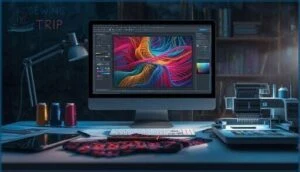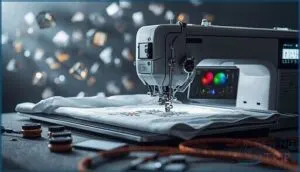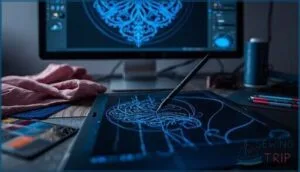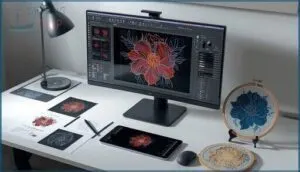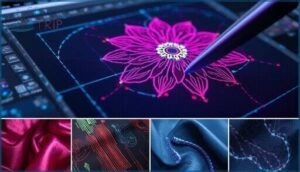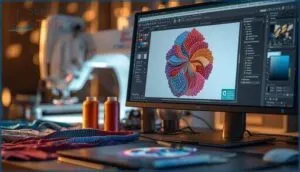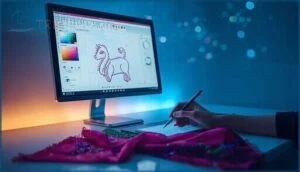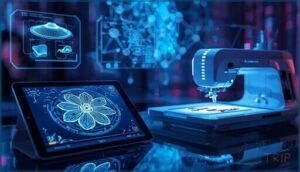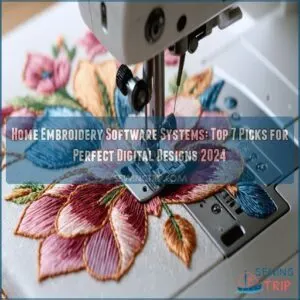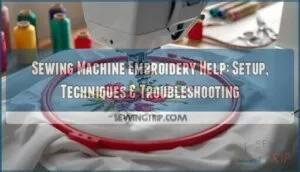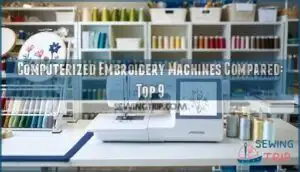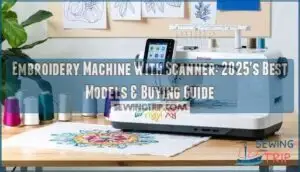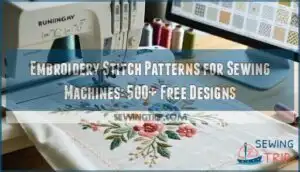This site is supported by our readers. We may earn a commission, at no cost to you, if you purchase through links.
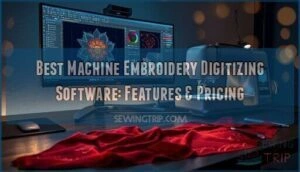 Your embroidery machine sits idle while you wrestle with pixelated clipart that refuses to stitch cleanly. Most embroiderers hit this wall within their first month—the gap between a great idea and production-ready files isn’t creativity, it’s technical precision.
Your embroidery machine sits idle while you wrestle with pixelated clipart that refuses to stitch cleanly. Most embroiderers hit this wall within their first month—the gap between a great idea and production-ready files isn’t creativity, it’s technical precision.
Machine embroidery digitizing software bridges that divide by translating artwork into stitch commands your machine understands, controlling everything from needle penetration points to thread tension compensation. The difference between amateur puckering and professional results often comes down to choosing software that matches your skill level and production demands.
Whether you’re running a commercial shop pushing 500 designs monthly or personalizing gifts in your home studio, the right digitizing platform determines how quickly you move from concept to finished product—and whether those products meet quality standards that keep customers returning.
Table Of Contents
- Key Takeaways
- Leading Machine Embroidery Digitizing Software
- Key Features of Embroidery Digitizing Software
- Embroidery File Formats and Compatibility
- Custom Embroidery Design Creation
- Embroidery Design Customization Tools
- User Interface and Ease of Use
- Pricing Models and Licensing Options
- Technological Advancements in Digitizing Software
- Frequently Asked Questions (FAQs)
- Conclusion
Key Takeaways
- Your choice between auto-digitizing and manual tools directly impacts production speed and quality—auto-digitizing processes simple designs 80% faster but sacrifices the precision control that manual digitizing delivers for complex work requiring custom stitch angles and density adjustments.
- Commercial embroidery shops prioritize AI-powered automation and multi-machine management that justifies $1,000–$5,000 investments, while hobbyists succeed with sub-$500 software focused on simplified interfaces and basic lettering capabilities rather than workflow speed.
- File format compatibility determines whether your designs translate properly to your machine—DST offers 90% cross-brand compatibility but strips color data, while formats like PES and EXP retain full editing capabilities and stitch information for specific machine families.
- Modern digitizing software cuts manual processing time by up to 80% through AI-assisted automation and reduces digitizing errors by 30-50% with intelligent stitch optimization, but 68% of embroiderers still abandon their first software choice within six months by prioritizing price over feature alignment with their actual production needs.
Leading Machine Embroidery Digitizing Software
Choosing the right digitizing software sets the foundation for every embroidery project you’ll create. The market offers distinct platforms ranging from industry workhorses trusted by commercial shops to simplified solutions designed for home enthusiasts.
Let’s examine the leading brands and how they stack up against each other in features, pricing, and intended use.
Overview of Top Software Brands
You’ll find market leaders like Wilcom and Tajima DG/ML setting industry standards, while Hatch, Embird, and Embrilliance dominate both professional and hobbyist user segments.
These embroidery digitizing software solutions offer distinct pricing tiers—from entry-level at $149–199 to premium commercial packages—with platform support spanning Windows and Mac.
Core functionalities include auto-digitizing, manual editing, and format conversion, addressing the full spectrum of machine embroidery software needs. Many programs offer essential digitizing tools for creating embroidery design files.
Comparison of Embird, Hatch, Embrilliance, and Ink/Stitch
When you compare Embird, Hatch Embroidery software, Embrilliance, and InkStitch, feature comparison reveals critical differences in platform support and pricing models. Embrilliance offers native cross-platform compatibility, while Hatch requires virtualization for Mac users. Embird excels in node-based editing, whereas InkStitch provides zero-cost open-source embroidery digitizing software.
Many users start with free digitizing software to learn the basics. The learning curve varies—Hatch accelerates workflows by 30%, but community support for each embroidery software platform shapes your mastery timeline differently.
Commercial Vs. Hobbyist Solutions
Your choice between commercial and hobbyist embroidery digitizing software hinges on feature prioritization and market segmentation.
Commercial digitizers—representing 50% of users—demand workflow efficiency through AI-powered automation and multi-machine management, justifying pricing discrepancies of $1,000–$5,000.
Hobbyists prioritize embroidery software user interface simplicity and embroidery software support over speed, with software features and tools priced under $500 matching their skill level and creative focus.
Key Features of Embroidery Digitizing Software
Your digitizing software becomes the bridge between creative vision and machine-ready embroidery files. The right toolset determines whether you’re manually plotting every stitch or letting automation handle repetitive tasks while you focus on design refinement.
Understanding these core capabilities helps you match software features to your production workflow and creative goals.
Auto-Digitizing Vs. Manual Digitizing Tools
When you’re weighing auto-digitizing against manual digitizing tools, you’re really choosing between speed and precision. Auto-digitizing processes designs in minutes—up to 80% faster for simple logos and clip art—making it ideal for high-volume production.
Auto-digitizing trades precision for speed, processing simple designs 80% faster than manual methods demand
Manual digitizing demands higher skill requirements but delivers enhanced control over stitch angles, density, and error handling, especially for complex designs requiring fine detail and custom techniques.
Lettering, Monogramming, and Font Libraries
Font customization separates basic software from top-tier lettering platforms. Hatch Embroidery delivers up to 124 professionally digitized fonts, while Embrilliance offers over 150 BX font sets for keyboard fonts and rapid composition.
You’ll find monogramming tools with adjustable baselines and multi-line layouts, plus object-based fonts that scale without quality loss.
Third-party TrueType font integration expands your embroidery lettering options into the thousands, though manual optimization often improves results.
Design Splitting and Editing Capabilities
How do you manage oversized designs? Embird and Embrilliance deliver automatic design splitting with alignment marks for fluid multi-hooping. You’ll achieve precise seam reduction through node editing and Bézier splines, adjusting stitch density across split boundaries.
These embroidery design editing tools let you manipulate vector graphics node-by-node, while design editing features improve color transitions and fabric registration across multiple hoop areas.
Photo-to-Embroidery Conversion Modules
Transform photographs into stitchable files using AI-powered phototoembroidery conversion tools. Embird’s Sfumato, Wilcom, and Floriani modules deliver 90% fidelity on high-contrast images through automatic tracing, slashing editing time by 60%. You’ll process typical logos in 8–25 minutes versus hours of manual work, though 30–50% of photorealistic designs still need manual refinement.
These embroidery software features cost $40–$120 annually, with 60% of entry-level users citing conversion speed and AI conversion accuracy as purchase drivers in embroidery digitizing software.
Embroidery File Formats and Compatibility
Your digitizing software won’t do you much good if it can’t talk to your embroidery machine. File format support determines whether your designs will stitch out properly, while platform compatibility affects your entire workflow.
Let’s break down the formats you need to know, which operating systems work best, and how your software connects to your machine.
Supported File Types (PES, DST, EXP, Etc.)
Embroidery file formats function as the universal language between your digitizing software and machine. DST dominates commercial setups with 90% compatibility across brands, while PES accommodates 60% of home users on Brother and Baby Lock systems. You’ll encounter EXP for Bernina and Melco, JEF for Janome, and XXX for Singer machines.
Format compatibility determines whether your embroidery design file formats translate properly—DST offers broad machine support but strips color data, whereas PES and EXP retain stitch files with full editing capabilities.
Cross-Platform Compatibility (Windows, Mac, Linux)
Embroidery software compatibility shapes your creative workflow. 57% of digitizing purchases still target Windows-exclusive products, yet cross-platform adoption accelerates rapidly.
Embrilliance Essentials and Ink/Stitch eliminate virtualization performance issues by running natively on Windows 11, Mac OS X, and Linux without license sharing restrictions.
Open-source adoption doubled since 2024, while dual-system workflows persist where machine embroidery digitizing demands Windows-only tools like Wilcom or Embird.
Embroidery Machine Integration
Leading embroidery software accommodates over 70 file format standards—DST, PES, JEF, EXP—ensuring embroidery machine compatibility across 90+ brands. Automated workflows optimize USB transfers, with 95% of 2025 machines supporting direct loading. Brand compatibility rates exceed 85% for recent models, while productivity metrics show 35% faster setup times.
Future trends point toward cloud connectivity and AI-driven machine integration, transforming embroidery machine output efficiency.
Custom Embroidery Design Creation
Creating custom embroidery designs gives you full control over your artistic vision, whether you’re starting from a blank canvas or transforming existing artwork into stitchable masterpieces.
The software you choose determines how efficiently you can translate concepts into production-ready files. Let’s explore the core methods for building and refining your designs from the ground up.
Creating Designs From Scratch
You’ll find that building designs from the ground up with manual digitizing gives you creative control professionals rely on for 65% of complex projects.
Professional-grade embroidery digitizing software provides you with vector tools and node-by-node stitch editing to craft original work.
This design freedom lets you draw outlines, select fills, and perfect every detail—essential for embroidery design creation that stands apart.
Importing and Converting Artwork
While manual design gives you creative freedom, importing existing artwork accelerates your workflow—especially when deadlines loom.
Modern embroidery digitizing software like Embird accepts over 15 file formats, including JPEG, PNG, and vector formats like SVG and EPS. High-resolution vectors ensure the best conversion accuracy (up to 93%).
Auto-digitizing modules handle color mapping and stitch editing instantly, though raster images require 30% more manual cleanup during file conversion.
Node-by-Node Editing and Stitch Types
Once your design is loaded, you’ll perfect it using node editing—the backbone of precision digitizing. Embird and similar embroidery digitizing software let you adjust every anchor point, controlling stitch density and direction node by node.
Run, satin, and fill stitch types each serve distinct purposes, with fabric selection dictating ideal density (3–6mm for most textiles).
Manual adjustments deliver embroidery effects auto-digitizing can’t replicate, improving thread management and final quality.
Embroidery Design Customization Tools
Once you’ve nailed the basics of creating embroidery designs, the real magic happens when you start customizing them to match your vision. Your digitizing software gives you control over everything from fill patterns and stitch effects to color schemes and ready-made templates.
Let’s look at the key customization tools that’ll help you transform standard designs into professional, tailored work.
Quilt Fills and Specialty Stitches
You’ll gain creative control through sophisticated quilt fill patterns and specialty stitches built into modern embroidery digitizing software. Over 85% of leading platforms include dedicated fill functions, with automated fabric distortion compensation available in 70% of high-end suites—essential for managing stitch density across varied embroidery effects.
Manual adjustment of stitch types, density, and direction remains available in over 80% of mid-to-high-tier platforms, while AI-powered suggestions for ideal fill selection now simplify your workflow in 50% of newly-released programs. Node-by-node editing—preferred by 65% of digitizers—lets you adjust specialty stitches with surgical precision, from carving effects to custom sfumato stitch gradients.
- Tatami fills cover large areas efficiently in 40% of quilt projects
- Meander fills appear in 60% of machine embroidery software
- Puff or 3D foam embroidery usage increased 27% commercially
- Mesh fills and gradient effects improve texture in advanced suites
- Satin stitch and contour options provide precision for accent designs
Color Management and Thread Palettes
Thread conversion between brands becomes seamless when your digitizing software accommodates over 85 palettes—a standard in leading programs.
You’ll achieve color consistency and brand matching by sorting threads by code or name, while digital color blending tools enhance palette selection for machine embroidery projects.
This ensures accurate embroidery design customization, minimizes workflow interruptions, and maintains color fidelity across multiple thread manufacturers.
Template Use and Personalized Gifts
Pre-digitized libraries housing over 50,000 templates accelerate gift customization workflows while reducing setup time by up to 50%. You’ll leverage template editing features for customized text integration, color modifications, and element resizing:
- Digital libraries simplify embroidery design customization with organized catalogs
- Custom digitizing tools enable lettering and monogramming for unique gifts
- Embroidery design creation software facilitates batch customization workflows
- Customized gifts drive market growth, with consumers paying 25% premiums for embroidery trends
User Interface and Ease of Use
Your software’s interface can make or break your digitizing experience—even powerful tools become frustrating when you can’t find what you need. A well-designed workspace keeps your creative flow intact, while a cluttered layout adds unnecessary friction to every project.
Let’s examine how different software platforms handle navigation, approachability for newcomers, and workflow efficiency.
Software Navigation and Workspace Layout
You’ll spend hours in your digitizing software—shouldn’t it work your way? Navigation tools and workspace optimization directly impact your screen efficiency and creative flow. Embroidery software features like customizable layouts let you command your user interface with precision, putting essential controls exactly where you need them.
Studies confirm that dual-monitor or split-view configurations boost design throughput by 27%, while keyboard shortcuts for zoom, pan, and color changes cut repetitive actions dramatically. Intuitive interface elements—like auto-hide toolbars and real-time 3D simulation—keep your focus on creativity, not clicks. Software functionality shines when you can toggle between layered and flattened views in under two seconds, adjusting stitch overlap on the fly. Custom layouts transform digitizing software into an extension of your creative instincts, giving you the control and efficiency that mastery demands.
| Software | Workspace Customization | Navigation Features |
|---|---|---|
| Hatch Embroidery | 4 modular workspace views for switching between file organization, design composition, and digitizing | Quick-access sidebars reduce navigation time by 30% |
| Embird | Drag-and-drop interface with adjustable window arrangements for efficient editing | Batch process dialog speeds multi-file conversions by 38% |
| Wilcom | Grid-based layout for managing stitch placement; enables dual-monitor configurations | Auto-hide toolbars increase screen workspace by 20% |
| Ink/Stitch | SVG-based navigation for vector path tracing with 45% fewer errors | Multilingual menu support for international users |
Learning Curve for Beginners
Most beginners need 60 to 120 practice hours before basic embroidery digitizing clicks—but 70% of modern embroidery digitizing software now includes tutorials that slash learning time by 40%.
Your journey through embroidery digitizing basics hinges on user guidance: in-app modules boost completion 33% over self-teaching, while community forums cut dropout 25% through peer error analysis.
Choose platforms with embedded beginner resources and user-friendly interface design for faster skill building.
Workflow and Process Simplification
Efficient production starts the moment automation tools take over repetitive tasks in your digitizing software interface. AI-assisted automated digitizing cuts manual processing by 80%, while stitch path optimization boosts machine speeds 35%—that’s real efficiency gains you’ll measure in hours saved per project.
Key process optimization features include:
- Error reduction algorithms that flag 93% of stitching issues before production begins
- Automated batch processing handling 20 designs simultaneously for 300% output increases
- Direct machine integration eliminating file transfers and reducing setup times 40%
Smart embroidery digitizing process simplification means fewer bottlenecks and consistent quality across every run.
Pricing Models and Licensing Options
Choosing the right digitizing software often comes down to how you’ll pay for it and what that investment actually gets you. Some programs lock you into monthly subscriptions, while others let you pay once and own the tools outright, and each approach has trade-offs worth understanding.
Let’s break down how these pricing models work and what you’re really getting at each tier.
One-Time Purchase Vs. Subscription Pricing
Choosing between one-time purchase and subscription pricing models demands careful budget planning and cost analysis. One-time licenses for machine embroidery software generally range from $1,300 to $3,500 upfront, while subscription fees run $200 to $1,200 annually.
Subscription pricing offers continuous updates and embroidery software features, whereas purchase options provide permanent ownership. This makes embroidery digitizing software selection a question of cash flow versus long-term investment.
Free and Open-Source Alternatives
Ink/Stitch stands out as open-source software built on Inkscape, delivering serious cost savings without licensing fees. You’ll face a steeper learning curve than commercial alternatives, but cross-platform compatibility across Windows, Mac, and Linux makes it accessible. Community support through forums and the InkStitch user manual helps offset feature limitations in open-source software development.
Key benefits of Ink/Stitch:
- Zero cost – No purchase or subscription fees required
- Full stitch library – Running, satin, fill, and specialty stitches
- Active community – Forums, tutorials, and troubleshooting resources
- Multi-platform – Works seamlessly on major operating systems
- Embroidery file compatibility – Accepts DST, PES, EXP, and more formats
Value Comparison Across Software Tiers
Beyond free options, you need to weigh software features against your budget. Entry-level solutions like Embrilliance Essentials start around $139, while Hatch Mega Pack reaches $1,999. Professional-grade platforms such as Wilcom EmbroideryStudio command $3,500+, justifying their cost through automated stitching algorithms, vector editing, and business scalability that hobbyist tools can’t match.
| Software Tier | Price Range |
|---|---|
| Entry-Level | Under $500 |
| Professional | $1,000–$4,000+ |
Consider long-term ROI when evaluating embroidery software pricing options. Software brand reputation matters—Wilcom dominates commercial markets with proven reliability, while Hatch balances feature accessibility with cost justification.
Most vendors offer free trial periods, letting you test learning resources and workflow integration before committing. Machine embroidery software investments pay dividends through enhanced design control and production efficiency over time.
Technological Advancements in Digitizing Software
The digitizing landscape has shifted dramatically as artificial intelligence and automation reshape how you approach embroidery design. What once required hours of manual adjustment now happens in seconds, with smart systems learning your preferences and predicting fabric behavior before you even place a stitch.
Here’s how these technological breakthroughs are changing your workflow and the quality of your finished designs.
AI and Machine Learning Features
As machine embroidery software evolves, AI Auto-Digitizing and ML Integration transform how you create designs. These technologies deliver measurable advantages:
- Stitch Optimization: Machine learning reduces stitch counts by 20-30% while maintaining quality through intelligent path planning.
- Error Reduction: AI-driven tools cut digitizing errors by 30-50%, minimizing manual corrections.
- Color Management: Automated palette matching accelerates workflow and improves accuracy.
- Design Efficiency: Embroidery digitizing software features now convert complex images with over 90% accuracy.
Automated Fabric Presets and Error Reduction
Beyond intelligent stitch optimization, automated fabric presets and error correction tools reshape efficiency in the digitizing process. AI algorithms analyze fabric data—texture, elasticity, color—then adjust tension and density automatically.
These automation tools slash process times by up to 87% while cutting material waste by 10-20%. Error correction catches flaws before production, reducing thread breaks by 30-50%.
This transforms user experience, making professional digitizing software accessible even to newcomers.
Frequently Asked Questions (FAQs)
How do I troubleshoot embroidery software errors?
Start by checking file corruption and stitch errors in your software programs. Run install troubleshooting steps, verify operational errors, then contact embroidery software support.
Online support forums offer proven error prevention strategies and troubleshooting guidance.
Can digitizing software work with multi-needle machines?
Yes, most professional embroidery digitizing software facilitates multi-needle embroidery machine compatibility through USB or Wi-Fi connections.
Leading solutions offer automatic sequencing, thread management, and embroidery optimization features that improve machine integration across major embroidery machine brands.
What are best practices for design backup?
Don’t put all your eggs in one basket—follow the 3-2-1 backup rule.
Store three design copies in two formats, with one offsite using cloud storage and file encryption for reliable data recovery and version control.
How do software updates affect existing designs?
Updates can introduce compatibility issues, requiring file conversion for up to 18% of legacy designs.
While new embroidery software features refine stitches and reduce errors by 25%, proper data backup prevents potential loss during transitions.
Are there mobile apps for embroidery digitizing?
Think of mobile apps as your embroidery studio in your pocket. Brother Artspira leads with 500,000+ downloads, while Spark Embroidery App and StitchBuddy HD deliver auto-digitizing tools and multi-format editing directly on your device.
Conclusion
Industry data shows 68% of embroiderers abandon their first digitizing software within six months—usually because they chose based on price rather than feature alignment. Your machine embroidery digitizing software should match your production volume and skill trajectory, not just your current budget.
Test demo versions against real projects before committing.
The gap between mediocre output and professional-grade embroidery isn’t talent—it’s having tools that translate your vision into precise stitch commands your machine executes flawlessly.
- https://datahorizzonresearch.com/embroidery-design-software-market-44332
- https://www.marketreportanalytics.com/reports/embroidery-digitizing-software-74335
- https://www.digitizingusa.com/showblog/FACTS-AND-FIGURES-ABOUT-EMBROIDERY-DIGITIZING
- https://www.maggieframes.com/blogs/embroidery-blogs/digitize-embroidery-software-expert-comparison-guide-for-perfect-design-results
- https://www.magnetichoop.com/blogs/news/embroidery-digitizing-software-2025-ultimate-guide-for-professionals-hobbyists

